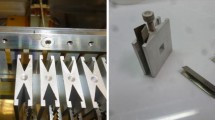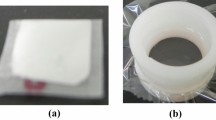Abstract
A 9Be-solution has been chemically prepared from phenakite (Be2SiO4) mineral grains as commercial 9Be-solutions are too high in long-lived 10Be. The solution is intended to be used as a carrier for radiochemical separation of 10Be to be measured by accelerator mass spectrometry (AMS). Thus, accurate data of the 9Be-concentration of this solution is essential to guarantee for high-accuracy 10Be data in the future. After devastating preliminary results (~8 % standard deviation), eight laboratories finally produced twelve individual results by four different analytical methods. A certain lab and method bias might be identified by sophisticated statistical evaluation. Some laboratories also (grossly) underestimate their uncertainties. Thus, the simple weighted mean of this round-robin exercise needed to be corrected by introducing additional allowances (Paule-Mandel-approach). The final result has been calculated to (2,246 ± 11) μg 9Be/(g solution) with a reasonably low weighted standard deviation of 0.49 %. The maximum deviation of a single lab value from the weighted mean is 2.4 % when removing one Grubbs outlier (11 % off from the mean) from the data set. As 10Be-data, which is usually calculated from measured 10Be/9Be by AMS and stable 9Be, cannot be more accurate than the determined 9Be-concentration, it seems highly advisable to establish or improve quality assurance by having self-made carrier-solutions analysed at more than a single lab and regularly taking part in round-robin exercises.


Similar content being viewed by others
References
Korschinek G, Bergmaier A, Faestermann T, Gerstmann UC, Knie K, Rugel G, Wallner A, Dillmann I, Dollinger G, von Gostomski Lierse, Ch Kossert K, Maiti M, Poutivtsev M, Remmert A (2010) A new value for the half-life of 10Be by Heavy-Ion Elastic Recoil Detection and liquid scintillation counting. Nucl Instrum Meth B 268:187–191
Gosse JC, Phillips FM (2001) Terrestrial in situ cosmogenic nuclides: theory and applications. Quat Sci Rev 20:1475–1560
Bischoff A, Weber D, Clayton RN, Faestermann T, Franchi IA, Herpers U, Knie K, Korschinek G, Kubik PW, Mayeda TK, Merchel S, Michel R, Neumann S, Palme H, Pillinger CT, Schultz L, Sexton AS, Spettel B, Verchovsky AB, Weber HW, Weckwerth G, Wolf D (1998) Petrology, chemistry, and isotopic compositions of the Lunar highland regolith breccia Dar al Gani 262. Meteorit Planet Sci 33:1243–1257
Fink D, Klein J, Middleton R, Vogt S, Herzog GF, Reedy RC (1998) 41Ca, 26Al, and 10Be in lunar basalt 74275 and 10Be in the double drive tube 74002/74001. Geochim Cosmochim Acta 62:2389–2402
Llorca J, Roszjar J, Cartwright JA, Bischoff A, Pack A, Ott U, Merchel S, Rugel G, Fimiani L, Ludwig P, Allepuz D, Casado JV (2013) The Ksar Ghilane 002 shergottite—the 100th registered Martian meteorite fragment. Meteorit Planet Sci 48:493–513
Altmaier M, Herpers U, Delisle G, Merchel S, Ott U (2010) Glaciation history of Queen Maud Land (Antarctica) using in situ produced cosmogenic 10Be, 26Al and 21Ne. Polar Sci 4:42–46
Braucher R, Merchel S, Borgomano J, Bourlès DL (2011) Production of cosmogenic radionuclides at great depth: a multi element approach. Earth Planet Sci Lett 309:1–9
McMillan EM, Ruben S (1946) Radioactivity of Be10. Phys Rev 70:123–126
McMillan EM (1947) Energy and Half-Life of the Be10 Radioactivity. Phys Rev 72:591–593
Arnold JR (1956) Beryllium-10 produced by cosmic rays. Science 124:584–585
Ehmann WD, Kohman TP (1958) Cosmic-ray-induced radioactivities in meteorites—II Al26, Be10 and Co60, aerolites, siderites and tektites. Geochim Cosmochim Acta 14:364–379
Raisbeck GM, Yiou F, Fruneau M, Loiseux JM (1978) Beryllium-10 mass spectrometry with a cyclotron. Science 202:215–217
Akhmadaliev S, Heller R, Hanf D, Rugel G, Merchel S (2013) The new 6 MV AMS-facility DREAMS at Dresden. Nucl Instrum Meth B 294:5–10
Lebatard A-E, Bourlès DL, Duringer P, Jolivet M, Braucher R, Carcaillet J, Schuster M, Arnaud N, Monié P, Lihoreau F, Likius A, Mackaye HT, Vignaud P, Brunet M (2008) Cosmogenic nuclide dating of Sahelanthropus tchadensis and Australopithecus bahrelghazali: mio-Pliocene hominids from Chad. Proc Natl Acad Sci USA 105:3226–3231
Wittmann H, von Blanckenburg F, Bouchez J, Dannhaus N, Naumann R, Christl M, Gaillardet J (2012) The dependence of meteoric 10Be concentrations on particle size in Amazon River bed sediment and the extraction of reactive 10Be/9Be ratios. Chem Geol 318:126–138
Bourlès DL, Raisbeck GM, Yiou F (1989) 10Be and 9Be in marine sediments and their potential for dating. Geochim Cosmochim Acta 53:443–452
Frank M, Porcelli D, Andersson P, Baskaran M, Björk G, Kubik PW, Hattendorf B, Guenther D (2009) The dissolved beryllium isotope composition of the Arctic Ocean. Geochim Cosmochim Acta 73:6114–6133
Lachner J, Christl M, Synal HA, Frank M, Jakobsson M (2013) Carrier free 10Be/9Be measurements with low-energy AMS: determination of sedimentation rates in the Arctic Ocean. Nucl Instrum Meth B 294:67–71
Merchel S, Arnold M, Aumaître G, Benedetti L, Bourlès DL, Braucher R, Alfimov V, Freeman SPHT, Steier P, Wallner A (2008) Towards more precise 10Be and 36Cl data from measurements at the 10−14 level: influence of sample preparation. Nucl Instrum Meth B 266:4921–4926
Arnold M, Merchel S, Bourlès DL, Braucher R, Benedetti L, Finkel RC, Aumaître G, Gottdang A, Klein M (2010) The French accelerator mass spectrometry facility ASTER: improved performance and developments. Nucl Instrum Meth B 268:1954–1959
Stone JOH (1998) A rapid fusion method for separation of beryllium-10 from soils and silicates. Geochim Cosmochim Acta 62:555–561
Sachs L (1992) Applied statistics, 7th edn. Springer, Berlin
Weise K, Wöger W (1994) Comparison of two measurement results using the Bayesian theory of measurement uncertainty. Meas Sci Technol 5:879–882
Neuilly M (1999) Modelling and estimation of measurement errors. Lavoisier Publishing Inc., Paris
Cox MG (2007) The evaluation of key comparison data: determining the largest consistent subset. Metrologia 44:187–200
Hässelbarth W, Bremser W, Pradel R (1998) Uncertainty-based evaluation of certification study data. Fresenius J Anal Chem 360:317–321
Quinn T (1997) Primary methods of measurement and primary standards. Metrologia 34:61–65
Merchel S, Bremser W, Akhmadaliev S, Arnold M, Aumaître G, Bourlès DL, Braucher R, Caffee M, Christl M, Fifield LK, Finkel RC, Freeman SPHT, Ruiz-Gómez A, Kubik PW, Martschini M, Rood DH, Tims SG, Wallner A, Wilcken KM, Xu S (2012) Quality assurance in accelerator mass spectrometry: results from an international round-robin exercise for 10Be. Nucl Instrum Meth B 289:68–73
Acknowledgments
The phenakite sample has been kindly provided by C. Varajão, Univ. Federal de Ouro Preto, Braisl. Measurements at GFZ Potsdam have been performed by Sabine Tonn. Discussion with and organisational skills by R. Braucher (CEREGE), V. Brendler (HZDR), A. Renno (HZDR), A. Ritter (HZDR) and G. Rugel (HZDR) are highly appreciated. The manuscript was clearly improved by taking into consideration comments of an anonymous reviewer. This work partially benefited from funding by the German Academic Exchange Service (DAAD PKz 500 888 61) and the Deutsche Forschungsgemeinschaft (DFG RU 1832/1-1).
Author information
Authors and Affiliations
Corresponding author
Rights and permissions
About this article
Cite this article
Merchel, S., Bremser, W., Bourlès, D.L. et al. Accuracy of 9Be-data and its influence on 10Be cosmogenic nuclide data. J Radioanal Nucl Chem 298, 1871–1878 (2013). https://doi.org/10.1007/s10967-013-2746-x
Received:
Published:
Issue Date:
DOI: https://doi.org/10.1007/s10967-013-2746-x




